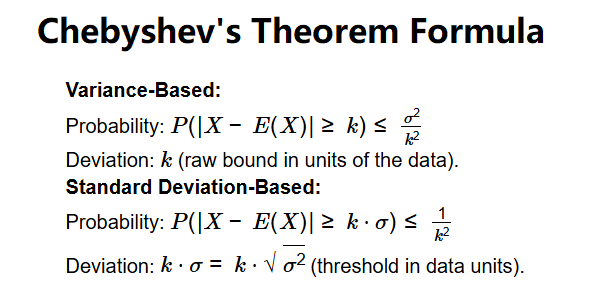1. What is a Chebyshev's Theorem Calculator?
Definition: This calculator uses Chebyshev's Theorem to estimate the divergence probability and deviation threshold, the likelihood and extent that a random variable deviates from its expected value by more than a specified bound. It offers two formulations based on variance and standard deviation.
Purpose: It supports statistical analysis, quality control, and risk assessment by providing upper bounds on data dispersion and concrete deviation ranges for any distribution with finite variance.
2. How Does the Calculator Work?
The calculator uses two formulas:
- Variance-Based:
- Probability: \( P(|X - E(X)| \geq k) \leq \frac{\sigma^2}{k^2} \)
- Deviation: \( k \) (raw bound in units of the data).
- Standard Deviation-Based:
- Probability: \( P(|X - E(X)| \geq k \cdot \sigma) \leq \frac{1}{k^2} \)
- Deviation: \( k \cdot \sigma = k \cdot \sqrt{\sigma^2} \) (threshold in data units).
- Where:
- \( X \): Random variable.
- \( E(X) \): Expected value (mean).
- \( \sigma^2 \): Variance.
- \( k \): Bound (must be > 1).
- \( \sigma \): Standard deviation (\( \sqrt{\sigma^2} \)).
Steps:
- Select formula type: Variance-based or Standard deviation-based.
- Input \( k \) (bound, > 1) and \( \sigma^2 \) (variance).
- Validate: \( k > 1 \), \( \sigma^2 \geq 0 \), no division by zero.
- Compute probability: \( \frac{\sigma^2}{k^2} \) or \( \frac{1}{k^2} \).
- Compute deviation: \( k \) or \( k \cdot \sqrt{\sigma^2} \).
- Convert probability to percentage (2 decimal places); keep deviation as a number (2 decimal places).
- Display both results (upper bound probability, deviation threshold).
3. Importance of Chebyshev's Theorem Calculations
These calculations are vital for:
- Statistics: Offers a universal bound for data variability and deviation ranges.
- Quality Control: Identifies outlier thresholds in manufacturing.
- Risk Assessment: Estimates extreme event likelihood and magnitudes in finance or engineering.
4. Using the Calculator
Examples:
- Variance-Based (\( \sigma^2 = 4 \), \( k = 2 \)):
- Probability: \( P \leq \frac{4}{2^2} = \frac{4}{4} = 1 \approx 100.00\% \).
- Deviation: \( k = 2 \).
- Result: 100.00% probability, 2.00 deviation threshold.
- Standard Deviation-Based (\( \sigma^2 = 4 \), \( k = 2 \)):
- Probability: \( P \leq \frac{1}{2^2} = \frac{1}{4} = 0.25 \approx 25.00\% \).
- Deviation: \( k \cdot \sqrt{\sigma^2} = 2 \cdot \sqrt{4} = 2 \cdot 2 = 4 \).
- Result: 25.00% probability, 4.00 deviation threshold.
5. Frequently Asked Questions (FAQ)
Q: Why add a divergence result?
A: It provides the actual deviation threshold, complementing the probability bound for practical use.
Q: Is the probability exact?
A: No, it’s an upper bound for any distribution with finite variance.
Q: How is deviation calculated?
A: For variance-based, it’s \( k \); for standard deviation-based, it’s \( k \cdot \sqrt{\sigma^2} \).
 Home
Home
 Back
Back
